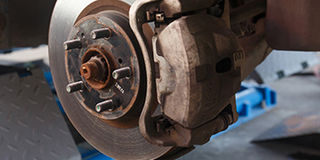How your car antilock brake system works

If you are intending to buy a car, buy one that has the ABS system in it because it keeps you safer on the road. NET PHOTO
Lately, most, if not all cars with the latest modern technologies are manufactured with a number of safety features such as the antilock brake system. Abbreviated as ABS, these three letters appear on your car dashboard enclosed in a small orange shape with a curve on either sides of the circle.
According to Samuel Ibudi, the Technical Training Assistant at Toyota Uganda Limited, technically, the antilock braking system prevents car wheels from locking.
If you are driving a car without the ABS and for some reason you find yourself in a scenario that requires emergency braking, if you step on the brake pedal during the emergency with a lot of force, the brake callipers will grip or attach to the brake rotors or brake discs to lock the wheels.
“If your car already had high speed momentum, it will overturn because you will have lost steering control because of the locked wheels. The car will skid if you are at a lower speed,” Ibudi explains.
How the ABS works
When you are in an emergency scenario such as dodging an animal that came onto the road unexpectedly and you step on the brake pedal, for a car with ABS, the sensors that are fitted on the four brake disks on the four wheels will capture data of how fast the wheel is decelerating or turning to communicate to the actuator that plays a role of determining how much braking pressure to apply.
The moment your car is about to come to a stop when stepping on the brake pedal, the antilock brake system sends a signal to release the brake calliper. The role of the calliper is to push the brake pads to get in contact with the brake disc to reduce speed or stop the car.
“The system keeps doing this until your driving speed has sufficiently reduced so that the car can be brought to a stop. The advantage of this is that the car will not skid or overturn. It allows you maintain the steering ability of the car to be safe,” Ibudi says.
With the ABS, the brake callipers come into play when the car is about to stop. Upon stepping on the brake pedal, the calliper is released to push the brake pads to touch the brake disc minimally, meaning that you would be applying hydraulic pressure.
It does this so fast for so many times that you cannot sense it. It is at this point that you will hear or feel a heavy noise as if metals under the car are grinding against each other.
“This is something normal because it means the ABS system is working. However, the noise does not have to be produced all the time you step on the brake pedal. The noise is produced when the system detects that you are braking for an emergency depending on the force with which you hit or step on the brake pedal,” Ibudi observes.
Parts that make up the ABS system
According to Ibudi, the ABS is made up of sensors that monitor the movement of brake discs. There are also tubes that transport hydraulic fluid from its tank or reservoir upto the callipers to avoid creating with the brake pads.
“You should not be convinced by any mechanic to disconnect the ABS system in your car. It never goes wrong if it is well-serviced. If you are intending to buy a car, buy one that has the ABS system in it because it keeps you safer on the road,” Ibudi advises.
ABS applicability
Isaac Mujjawa, a mechanic at Makindye, notes that the ABS does not only come in brand news cars only; it is also existent in second hand cars sold in bonds. As long as your car has the system, it will always have or show an indicator lamp on your dashboard.
In some brands, the antilock brake system is sometimes known as the emergency or preventive braking system but with the same functionality- preventing wheels from locking in case of emergency braking.
Functionality of the ABS
The ABS will still function even if you are driving at 80km or 100km/hour unless it has a defect. The defect can be as a result of a number of things.
It could be a sensor that is faulty or even a faulty brake system. Under such circumstances, do not expect the ABS to function the way it ought to.
Service for the ABS
Mujjawa cautions that if your brake pads are worn out, replace them immediately before they cause cracks to the brake disc.
The brake disc should as well be smooth and not warped or deformed in any way.
If it is, it should be skimmed or resurfaced.
Brake disc resurfacing is the process by which the disc is made flat using a specialised machine to give it its initial smooth texture.
Causes of brake disc warping
Your brake disc can get warped if your car was involved in an accident or if it has been corroded by a chemical or scratched. If you also use the wrong type or quality of brake pads, it will reduce the lifespan of your brake disc because it will be scratched.
This will compromise the braking system. Brake disc warping could as well be due to braking heat that forces it to expand and contract because of too much friction. The discs are built and given room to expand and contract but with time, you will notice that it will get deformed, a condition where it (brake disc) should undergo skimming or resurfacing.




